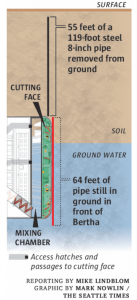The WSDOT finally fessed up that an abandoned pipe casing is the culprit choking its beloved Bertha. Turns out that contractors were supposed to know that the 8-inch diameter, 119-foot-long well casing was there. Furthermore, the pipe had been placed as part of a study to measure groundwater during research for the Alaskan Way Viaduct replacement project.

WSDOT officials stated on Friday that they had hit the pipe on December 3, when Bertha pushed it six to seven feet out of the ground. Workers then pulled up a 55-foot long piece of the pipe, apparently thinking that they had gotten out the entire thing. According to spokesperson Chris Dixon, when Bertha then started to chew up a boulder, it gave them “a false sense of security.”
Several issues stand out about this story. As someone focused on Seattle’s history, I thoroughly enjoyed so many people taking such an interest in the buried stories of our city’s past. I can only hope that people will continue to want to learn more of these stories. As a geologist, I also enjoyed the focus on Seattle’s geologic past, Plus anything that can get more people to say “glacial erratic” is fine by me.
More disturbing though, is the reticence of WSDOT on the pipe casing. In the week after the initial stoppage, a buddy of mine had told me the exact story that WSDOT is now telling. Why didn’t they just tell us immediately? Their excuses now just seem to be self-serving, a particularly bad precedent for an agency known for making a few huge errors. I recognize that they might not have been able to do anything, and all of the fun speculation would not have occurred, but it seems that being truthful certainly wouldn’t hurt WSDOT.
One positive aspect of the pipe story is that as the drill progresses, it will move completely away (at least it is supposed to) from any area where human-created objects could block Bertha. That does not mean that there won’t be any erratics, or other glacially deposited boulders, to get in the way, but at least Bertha was designed to cut through them.
I suspect though that this won’t be the last time Bertha will be in the news.